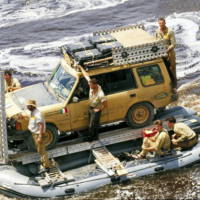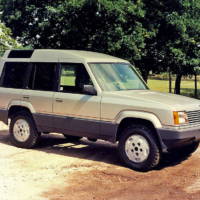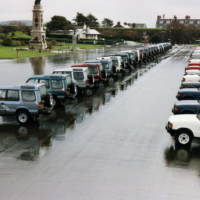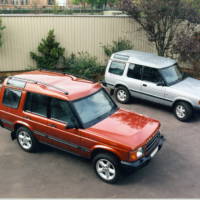The Land Rover Discovery was first launched on the 16th of November 1989 and today the well known 4×4 is celebrating 20 years of presence on the market.
The British manufacturer reminds us that in the 20 Years of Land Rover Discovery the vehicle had fulfilled many duties, from a workhorse to tow car, law enforcer, status symbol, people carrier or mud plugger.
20 years ago the Land Rover Discovery was entering the market as a vehicle that would fill the gap between the Land Rover Defender and the luxurious Range Rover, and by this date over 900,000 units have been sold.
The company’s Managing Director, Phil Popham says the Discovery "is truly the best loved SUV the world over" and if you want to know 20 interesting facts about the Land Rover Discovery then follow the official press release below.
Land Rover press release :
Workhorse, tow car, law enforcer, status symbol, people carrier, mud plugger; few cars can claim to fulfil any of these duties with genuine conviction. Yet since 16 November 1989 – 20 years ago today – one car has consistently met all those challenges and more, earning itself iconic status as the ultimate all-purpose vehicle. That car is the Land Rover Discovery.
Designed originally to plug the gap between the utilitarian attributes of the iconic Land Rover Defender and the more luxurious characteristics of the flagship Range Rover, Discovery soon became the perfect niche vehicle for the growing demands of the family 4×4 market.
"The Discovery legend has been built on innovative design and advanced technology. From the introduction of high-efficiency direct-injection diesel technology into the 4×4 market in 1989, to pioneering occupant safety with the adoption of twin airbags in 1998, Discovery has led the way." says Phil Popham, Managing Director. "It is truly the best loved SUV the world over. Today, we sell the Discovery in 91 countries and sales to date have hit over and above 900,000,"
he adds.
Having revolutionised the mid-sized 4×4 sector in 1989, it’s no surprise that the Discovery evolved to reflect the needs and tastes of its increasingly urbane and discerning buyers. By 1994 range-topping Discovery models featured leather upholstery and wood veneer trim, and when the Series II Discovery was introduced in 1998 it added a sophisticated new heating, air-conditioning and ventilation system for increased comfort in all climates. Today’s Discovery 4 continues that ethos of evolution to winning effect: Its strikingly architectural interior design, clear-yet-stylish dashboard, user-friendly features and luxurious interior creating an attractive, well-appointed and practical environment for driver and passengers alike.
The Discovery will be forever renowned for its legendary exterior shape which to this day still continues the stepped roof and asymmetric rear glass theme, giving all occupants a clear view of the journey ahead. To provide a contemporary edge to the interior design, Land Rover turned to the Conran Design Studio who for many years have been held in high regard for influencing ‘modern day living’.
"Discovery has evolved its own clear design heritage over four generations.
Today, Discovery 4 stays true to its clean, geometric, architecturally-inspired predecessors. Its new front bumper, lights and face, smoother lines and subtle curves, combine to enhance the overall impression of premium quality," says Gerry McGovern, Design Director.
Versatile and Practical
While go-anywhere ability is synonymous with any Land Rover product, the Discovery’s enduring success comes from a combination of all-terrain capability and all-important practicality for the demands of family life. Like its predecessors, Discovery 4 comes with seven seats – the rearmost pair now offering legroom for full-sized adults, providing a versatile space for family and friends.
Increased style and comfort have never come at the expense of the Discovery’s dynamic ability. Indeed generations of horse riders, caravaners, boat owners and car racers can all testify to the Discovery’s towing prowess. It’s a tradition Discovery 4 proudly upholds with Tow Assist, which helps the driver perform otherwise tricky towing manoeuvres, and Trailer Stability Assist, which reduces engine torque and uses programmed braking applications to regain control over a snaking trailer. Two honours at the recent Caravan Club Towcar of the Year Awards 2010 are fitting recognition of Discovery 4’s utilitarian qualities and on-going commitment to safety.
The evolutionary Discovery 4 looks set to follow on from the enormous success of its predecessor. Since its launch back in 2004, the Discovery 3 has achieved global acclaim winning a staggering 111 awards worldwide, including the honour of SUV of the year from countries as diverse as Mexico, Russia and Greece.
In 2004, the Discovery 3 introduced another significant first: Terrain ResponseTM. This patented system allows the driver to actively tune the car’s systems (including engine, suspension and traction control settings) to optimise their vehicle for virtually any driving situation, from urban jungle to gnarly wilderness. Terrain Response has since been recognised in the Queen’s Awards For Enterprise for Innovation. Land Rover previously received this prestigious award for its patented Hill Descent Control and an enhanced version of this technology remains key to the dynamic capabilities of the new
Discovery 4 with the addition of Gradient Release Control.
In 2006, Land Rover launched a pioneering CO2 offset programme with Climate Care which is now the biggest scheme of its kind in the world. The emissions from the first 45,000 miles of all new Land Rovers sold in an increasing number of markets is offset to help fund environmental projects on a global scale. Improvements introduced with the launch of Discovery 4 earlier this year, now help deliver substantially lower emissions with the highly fuel efficient LR-TDV6 3.0 sequential turbodiesel, delivering over 30mpg on the combined EU cycle.
Adaptable, capable, indefatigable, unmistakable; the Discovery legend is wholly deserved. Here’s to the next 20 years.
LAND ROVER DISCOVERY : 20 FACTS
1. Discovery has evolved its own clear design heritage over four generations.
The subtle kick-up in the roofline of the latest Discovery 4/LR4 is a deliberate visual reference to the original Discovery, where a raised rear roof section was necessary to give enough headroom for passengers in the rearmost seats.
2. 392,443 first-generation Discoverys were built in nine years, for an average of 43,604 per year. There were 278,570 Series II models in six years, for an average of 46,428 per year. Discovery 3/LR3 reached a total of 220,057 in five years (an average of 44,011 per year) before giving way to the 2010 model-year Discovery 4/LR4.
3.Fuel economy has always been a target of Discovery’s diesel engines, and a
third-generation common-rail fuel system allows the latest 3.0-litre TDV6 to achieve 9.7 percent better fuel economy than its smaller-capacity predecessor on the combined EU cycle. The pioneering direct-injection system used for the TDi engines of the first-generation Discovery was specifically intended to deliver class-leading economy, as was the use of Electronic Unit Injectors on the Series II models’ TD5 diesel engine.
4. The first Discoverys in 1989 were launched as three-door models, the family-oriented five-door followed in 1990 on the same wheelbase. A three-door Discovery Series II was built as a full-size mock-up, but customer demand dictated that five-doors was the way forward so no three-door Series II was ever put into production.
5. All-round visibility for the driver has always been a pre-requisite on the Discovery, reinforced by the high-set Command Driving Position. On Discovery 4, the driver’s ability to see every inch of the vehicle when manoeuvring is aided by no fewer than five miniature cameras. Pictures are transmitted to the dash-mounted information screen and can function at speeds up to 11mph.
6. The first Discoverys shared their headlights with the Freight Rover van, and shared their rear lights with the Austin Maestro van. Very early examples were built with tail-lights carrying the Austin-Rover logo, but the Land Rover oval soon took pride of place when volume production got under way.
7. During the development phase of the Discovery 3, a total of 75 prototypes were taken to the four corners of the earth to test the exceptional breadth of capability of this multi award-winning vehicle, taking it to extremes of +50 degrees centigrade to a teeth-chattering minus 30 degrees centigrade.
8. The side graphics characteristic of the original three-door Discoverys were very fashionable in the late 1980s and are now a distinguishing feature of the early models. The graphics changed in 1992 but after 1994 the graphics were phased out to reflect a change in car ‘fashion’.
9. Land Rover’s spirit of adventure is often recalled at the mention of the famous Camel Trophies. The competitions of the 1990s saw the Discovery tackle the so-called ‘Olympics of 4×4’. Specially prepared examples were used as the crew vehicles for the eight years from 1990 to 1997. Some countries sold special Camel Trophy limited editions with many still clearly visible on the roads today.
10. In 1993, Land Rover Special Vehicles used the three-door body shell to create the Discovery Commercial or ‘van’ derivative. With proven all-round versatility, there have been Commercial derivatives of the Series II, Discovery 3 and now Discovery 4 – all based on the standard five-door body.
11. To mark Land Rover’s 60th anniversary in 2008, 60 vehicles were donated to the British Red Cross Society and its sister national societies around the world. The Discovery 3 was among the 60 vehicles arranged in the form of the Red Cross flag in the quadrangle of Buckingham Palace for the official handover on 9th July.
12. Among the options of the first Discoverys was a shoulder bag trimmed to match the seats of your vehicle which could be attached to the centre console. These bags now command quite a high premium with Land Rover enthusiasts.
13. Since its launch in 2004, Discovery 3 has achieved tremendous global acclaim with a total of 111 awards! From Russia to Mexico, Discovery is the best loved SUV the world has ever driven.
14. Discovery 3 and Discovery 4 have electronically controlled all-independent air suspension, which delivers a superb on-road ride and improves off-road ability, too. The first two generations of Discovery had beam axles with coil springs – although self-levelling air springs were fitted to the rear of top-model Series IIs.
15. The longest first-generation Discoverys built at the Land Rover factory had a 116-inch wheelbase and were designed as fast-response paramedic ambulances.
16. A Discovery 3 was the four millionth Land Rover to leave the production lines on 8th May 2007. Donated to one of Land Rover’s key conservation sponsors – the Born Free Foundation – founder patron Joanna Lumley joined employees to celebrate this milestone and accept the keys on behalf of the charity. The Discovery was deployed as a ‘Rapid Response Rescue’ vehicle.
17. Between 1994 and 1996, the Discovery was sold in Japan as the Honda Crossroad. It wore the badges of the Rover Group’s then business partner, but was otherwise identical to the standard product.
18. Discovery was the first Land Rover programme to fully utilise CAD technology. The exterior of the Discovery was fully surfaced in CAD to enable prove out models and tooling to be created. The interior was created in a wire frame format in CAD.
19. A light and airy interior has always been a Discovery trademark. Deep windows and Alpine lights in the roof have been a constant feature since the beginning, supplemented by glass sunroofs – optional on early models but now standard on the latest Discovery 4.
20. The original project code name for Discovery was Project Jay. This was because of the naming policy put in place by Alan Edis to enhance prototype secrecy – projects were named in alphabetical order, following bird and animal themes.
20 Years Of Land Rover Discovery Video :



























